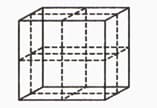Jaikishan and Premkishan Solutions for Exercise 1: Let us Practice
Jaikishan Reasoning Solutions for Exercise - Jaikishan and Premkishan Solutions for Exercise 1: Let us Practice
Attempt the practice questions from Exercise 1: Let us Practice with hints and solutions to strengthen your understanding. How to Crack Test of Reasoning in All Competitive Exam solutions are prepared by Experienced Embibe Experts.
Questions from Jaikishan and Premkishan Solutions for Exercise 1: Let us Practice with Hints & Solutions
Select the cube which can be made from the following sheet of paper.

A cube, which is painted red on the outer surface, is 2 inches high, 2 inches wide and 2 inches across. If it is cut into one inch cubes, as shown by dotted lines, then indicates the number of cubes which are red on two sides?

A cube has six numbers marked , , , , and on its faces. Three views of the cube are shown below.

What possible numbers can exist on the two faces marked A and B, respectively?

Thee different positions of a same dice are given below. What will come in place of ‘?’.

Read the following information carefully to answer the questions that follow.
A cuboid of dimensions (6 cm X 4 cm X 1 cm) is painted black on both the surfaces of dimensions (4 cm X 1 cm), green on the surfaces of dimensions (6 cm X 4 cm) and red on the surfaces of dimensions (6 cm X 1 cm). Now, the block is divided into various smaller cubes of side 1 cm each. The smaller cubes so obtained are separated.
How many cubes will have at least two colours?
Read the following information carefully to answer the questions that follow.
A cuboid of dimensions is painted black on both the surfaces of dimensions , green on the surfaces of dimensions and red on the surfaces of dimensions . Now, the block is divided into various smaller cubes of side each. The smaller cubes , so obtained are seperated.
How many cubes will have 4 coloured sides and two faces without colour?
Read the following information carefully to answer the questions that follow.
A cube is coloured red on two opposite faces, blue on two adjacent faces and yellow on two remaining faces. It is then cut into two halves along the plane parallel to the red faces. One piece is then cut into four equal cubes and the other one into equal cubes.
How many cubes will not have any coloured faces?
Read the following information carefully to answer the questions that follow.
A cube is coloured red on two opposite faces, blue on two adjacent faces, and yellow on two remaining faces. It is then cut into two halves along the plane parallel to the red faces. One piece is then cut into four equal cubes and the other one into equal cubes.
How many cubes will not have any red faces?
